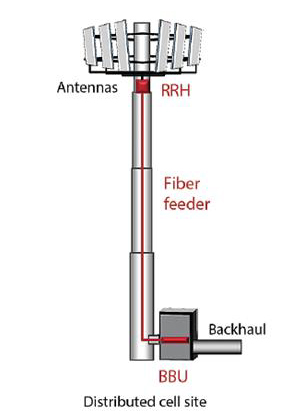Chapter 2: D-RAN
D-RAN
The Issues with Distributed Radio Access Networks
In this section, you’ll learn how most telecoms operators organize their existing Radio Access Networks and find out why this design has been called into question.
An Overview of Distributed Radio Access Networks
A Radio Access Network (RAN) is the connected network used by telecommunications providers and others to provide mobile and smart device connectivity to end users. The network is designed to handle speech, SMS, multimedia, and data connections.
The main configuration that telecoms companies used is known as Distributed RAN (D-RAN). It’s a distributed network because it spreads the processing power required to keep the network running over many independent radio towers. These towers are also known as Base Stations.
D-RAN towers are designed to be self-contained and independent – each one is able to send, receive, capture, and process communications by itself.
Terminology
We use the term “Base Station” to describe the individual nodes in the D-RAN system, but these towers can have different names depending on the type and specifications of the technology used.
For example:
• “Base Transceiver Station” (BTS) is used for towers that carry EDGE 2G technology.
• “NodeB” is used for 3G towers.
• “eNodeB” is used for 4G towers.
How a Base Station is Constructed
A base station is built from several distinct elements.
Antennas
These devices are used to send and receive radio communications within a range of the tower.
Remote Radio Heads (RRH)
These devices are located near the top of the radio tower antennas. They control the transmission (broadcast) and reception (capture) of radio waves for the tower.
Fibre Feeder
The fibre feeder carries data from the RRHs down to the BBU.
Baseband Unit (BBU)The BBU processes all the data sent and received by the Base Station. In a D-RAN configuration, every tower has its own dedicated BBU.

Base Station Networks and Central Controllers
All base stations are connected to a central Base Station Controller. This controller allows all connected base stations to be monitored and managed remotely. These central controllers also connect the individual towers and base stations to the Core Network.

This is how 4G D-RANs work – it’s an architecture based on independent towers that can send, receive and process data independently. The dedicated BBU and RRHs in each station ensures it can work by itself and interact with the central controller when needed.
This model certainly has many benefits. It has revolutionized how we send and receive voice, data, and more. It has driven adoption of EDGE, 3G and 4G connections and made mobile networks accessible across cities and remote areas.
Unfortunately, with the exponential avalanche of data that’s now being generated, sent, and received, D-RAN is starting to show its age.
The Issues with Using D-RAN Architecture
Excessive Cost of D-RAN
D-RAN architecture is very expensive to install, expand, and maintain. This has a significant impact on the capital and operational expenditure of telecom companies. There are several
reasons for these large expenses:
• Independent towers take up a lot of space and have a large “footprint,” meaning that telecoms companies need to rent space for each tower. This can get expensive, especially
in cities.
• Due to the amount of data and processing they are carrying out, they consume lots of electricity.
• All the base station equipment must be carefully protected against the weather.
The high CAPEX and OPEX costs of these independent base stations mean that continuing to use them will significantly reduce the profits of telecoms businesses, and it’s not viable in the long-term.
Inefficient use of equipment
Investments in D-RAN can be extremely wasteful due to how the network is constructed and configured. Because base stations are independent, each one is designed to deal with the maximum
demand of a region.
Most of the time, actual usage doesn’t come close to maximum demand, meaning there’s a lot of wasted capacity.
Let’s explore this issue using the example of a sports stadium.
When a sports stadium telecoms network is being designed, it’s assumed that big events like concerts or playoff games will cause the network to operate at maximum capacity.
In these situations, plenty of data will be sent and received by mobile devices due to streaming, media, updates, and other services.
Any base stations serving that stadium will be configured to meet those high demands.
——————image———————
Image of the Stadium in full hours
Of course, as soon as the stadium empties, that data consumption becomes negligible. All the powerful base station equipment will be idle.
This means the equipment’s capacity is wasted most of the time. In fact, the base stations of most telecom companies only operate at around 30% of their maximum capacity.
Inefficient use of radio frequency
In large cities, the expansion of the D-RAN creates unique complications. In busy locations, there can easily be more than 1,500 radio cells [PM1]in every square kilometre (0.4 square miles).
The lack of coordination between independent cells forces the antennas to compete for the limited radio frequencies available. This can cause interference between radio signals and further
complicate D-RAN operation and expansion.
Solutions to the D-RAN Dilemma
These challenges demand answers. Telecom companies are seeking efficient, cost-effective solutions that will allow their networks to deal with the increasing demands generated by the Internet
of Things devices and 5G.
The answer isn’t a simple one, and there are many innovations and technologies needed to deliver future-proof communications networks. One of the most promising solutions is a move away from D-RAN to Centralized RAN or C-RAN.
In the next section, we’ll demonstrate how a move to C-RAN can make radio access networks cheaper, more capable, faster, and more efficient than ever before.
Date
Febbraio 4, 2019
